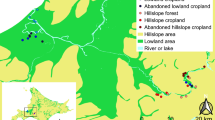Abstract
Fire is a frequent and common disturbance factor in Mediterranean ecosystems. It is a most spectacular ecological force because it destroys ecosystems in a very short time. Pinus brutia Ten. forests, which are one of the most widespread ecosystems in the eastern Mediterranean rim, have developed adaptations against fire. The adaptations evolved by plant species have been studied extensively. However, the response of insects, which are an important part of the ecosystem, has received little attention. In this study, we investigated the effects of fire on the community structure of Buprestidae over the long term and along a successional gradient. The study was carried out at the Marmaris National Park (N 36°50′, E 28°17′), which is located in southwestern Turkey. Four sites were selected to represent the different stages of succession. Buprestids were sampled using sweep nets with a 32-cm diameter that were swung 200 times while walking along a 100-m transect in three sampling lines. Total abundance, species richness and the Shannon diversity index were used in order to compare the Buprestidae community at different successional stages. Twenty-seven individuals belonging to 11 species were found. Total abundance and species richness decreased with successional age. Both parameters were significantly and negatively correlated with time since fire (respectively rs=−0.547, P=0.013, n=20; rs=−0.479, P=0.033, n=20). The results showed that fire affects the Buprestidae community through food supply and changes of habitat. Buprestidae species benefited from conditions that occurred after fire. Weakened trees, spread branches and trunks constituted suitable food resources for the wood-boring beetles in early successional sites. In addition, because of the low abundance of Buprestidae species, no damages were observed on pine seedlings in early successional sites.

Similar content being viewed by others
References
Andersen AN, Müller WJ (2000) Arthropod responses to experimental fire regimes in an Australian tropical savannah: ordinal-level analysis. Aust Ecol 25:199–209
Booth RG, Cox ML, Madge RB (1990) IIE guides to insects of importance to man. 3. Coleoptera. Cambridge University Press, Cambridge
Brower JE, Zar JH, von Ende CN (1990) Field and laboratory methods for general ecology. Brown, Dubuque, IA
Haim A, Izhaki I, Golan A (1996) Rodent species diversity in pine forests recovering from fire. Isr J Zool 42:353–359
Lawton JH (1983) Plant architecture and the diversity of phytophagous insects. Annu Rev Entomol 28:23–39
Lodos N, Tezcan S (1995) Türkiye Entomolojisi V Buprestidae (Genel Uygulamalı ve Faunistik). Entomoloji Derneği Yayınları No. 8, Ege Üniversitesi Basımevi, İzmir
McIntosh RL, Katinic PJ, Allison JD, Borden JH, Downey Dl (2001) Comparative efficacy of five types of trap for woodborers in the Cerambycidae, Buprestidae and Siricidae. Agric For Entomol 3:113–120
Moretti M, Zanini M, Conedera M (2002) Faunistic and floristic post-fire succession in southern Switzerland: an integrated analysis with regard to fire frequency and time since the last fire. In: Viegas DX (ed) Forest fire research and wildland fire safety. Proceedings of the IV international conference on forest fire research. Mill Press, Rotterdam
Orgeas J, Andersen AN (2001) Fire and biodiversity: responses of grass-layer beettles to experimental fire regimes in an Australian tropical savanna. J Appl Ecol 38:49–62
Schmitz H, Bleckmann H (1998) The photomechanic infrared receptor for the detection of forest fires in the beetle Melanophila acuminate (Coleoptera: Bubrestidae). J Comp Physiol A 182:647–657
Siemann E (1998) Experimental tests of effects of plant reproductivity and diversity on grassland arthropod diversity. Ecology 79(6):2057–2070
Siemann E, Haarstad J, Tilman D (1999) Dynamics of plant and arthropod diversity during old field succession. Ecograph 22:406–414
Smith JK (2000) Wildland fire in ecosystems, effects of fire on fauna. US Department of Agriculture Forest Service, General Technical Report RMRS-GTR-42, vol 1
Southwood TRE (1979) The relationships of plant and insect diversities in succession. Biol J Linn Soc 12:327–348
Thanos CA, Doussi MA (2000) Post-fire regeneration of Pinus brutia forests. In: Ne’eman G, Trabaud L (eds) Ecology, biogeography and management of Pinus halepensis and P. brutia forest ecosystems in the Mediterranean Basin. Backhuys, Leiden, pp 291–301
Trabaud L, Prodon R (1993) Preface. In: Trabaud L, Prodon R, (eds) Fire in Mediterranean ecosystems. E. Guyot, Brussels, pp 7–9
Whelan RJ (1995) The ecology of fire. Cambridge University Press, Cambridge
Wikars LO (2001) Dependence on fire in wood-living insects: an experiment with burned and unburned spruce and birch logs. J Insect Conserv 6:1–12
Wikars LO (1992) Skogsbränder orch inseckter. Entomologisk Tidskrift 113(4):1–12
Wikars L, Schimmel J (2001) Immediate effects of fire-severity on soil invertebrates in cut and uncut pine forests. For Ecol Manage 141:189–200
Acknowledgements
We thank Sinan Kaynaş and Çağatay Tavşanoğlu for their assistance during sampling. We also thank Osman Sert for his help in identifying specimens. This work was supported by Hacettepe University, Unit of Scientific Research (Project No. 00.02.601.005).
Author information
Authors and Affiliations
Corresponding author
Rights and permissions
About this article
Cite this article
Kaynaş, B.Y., Gürkan, B. Changes in Buprestidae (Coleoptera) community with successional age after fire in a Pinus brutia forest. J Pest Sci 78, 53–55 (2005). https://doi.org/10.1007/s10340-004-0067-0
Received:
Published:
Issue Date:
DOI: https://doi.org/10.1007/s10340-004-0067-0




